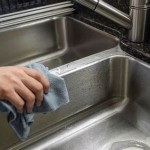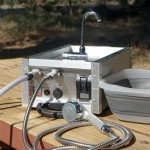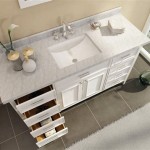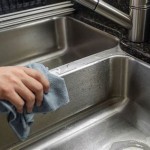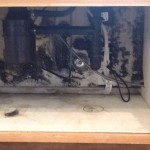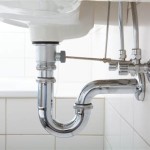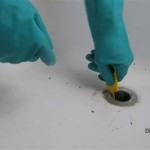How To Get a Kitchen Sink To Drain
A clogged kitchen sink is a common household problem that can disrupt daily routines and create unsanitary conditions. Addressing the issue promptly is crucial to restore functionality and prevent further complications. This article provides a comprehensive guide to diagnosing and resolving kitchen sink drainage problems, offering various techniques ranging from simple solutions to more involved procedures.
Identifying the Cause of the Clog
Before attempting any solutions, it's important to determine the potential cause of the blockage. Kitchen sink clogs typically result from the accumulation of food particles, grease, soap scum, and other debris within the drainpipe. The drainpipe configuration, including the P-trap and any connecting pipes, can also contribute to the problem.
Common culprits include:
- Food Scraps: Small bits of food, such as rice, pasta, and coffee grounds, can accumulate over time and form a solid mass within the drain.
- Grease and Oil: When poured down the drain, grease and oil solidify as they cool, clinging to the pipe walls and trapping other debris.
- Soap Scum: The combination of soap and hard water minerals can create a sticky residue that narrows the drainpipe.
- Hair: While more common in bathroom sinks, hair can sometimes find its way into the kitchen drain, especially if food preparation involves dealing with animal products.
- Foreign Objects: Accidental introduction of small objects, such as utensils or bottle caps, can obstruct the drainpipe.
Understanding the likely cause will help determine the most effective method to clear the clog.
Simple Solutions for Minor Clogs
Often, a minor clog can be addressed with simple household methods that require minimal effort and readily available materials.
1. Hot Water:
Pouring boiling water down the drain can dissolve grease and loosen other debris. This method works best for minor clogs caused by grease accumulation. However, it is essential to exercise caution when using boiling water, especially with PVC pipes, as excessive heat can potentially damage them. Check the pipe material under the sink before attempting this method. If PVC is present, use very hot tap water instead of boiling water.
Process: Boil approximately one gallon of water. Carefully pour the boiling water down the drain in stages, allowing each stage to work for a few seconds before pouring more. Observe if the water begins to drain more freely.
2. Baking Soda and Vinegar:
The combination of baking soda and vinegar creates a chemical reaction that can help break down clogs. This is a safe and environmentally friendly alternative to harsh chemical drain cleaners.
Process: Pour one cup of baking soda down the drain, followed by one cup of vinegar. Let the mixture fizz for about 30 minutes. Flush the drain with hot water.
3. Plunging:
A plunger creates suction that can dislodge clogs. Using a cup plunger (the type without a flange) specifically designed for sinks is recommended.
Process: Ensure there is enough water in the sink to cover the cup of the plunger. Place the plunger over the drain opening, creating a tight seal. Push and pull the plunger up and down vigorously for several minutes. Remove the plunger and check if the water drains. Repeat the process if necessary.
Advanced Techniques for Stubborn Clogs
If the simple solutions are ineffective, more advanced techniques may be required to clear the clog. These methods often involve accessing the drainpipe directly and manually removing the obstruction.
1. Cleaning the P-Trap:
The P-trap is a U-shaped section of pipe located under the sink. Its primary function is to trap debris and prevent sewer gases from entering the home. The P-trap is also a common location for clogs to form.
Process: Place a bucket under the P-trap to catch any water or debris. Loosen the slip nuts that connect the P-trap to the drainpipes. Carefully remove the P-trap and empty its contents into the bucket. Inspect the P-trap for any obstructions and remove them. Clean the P-trap thoroughly with water and a brush. Reassemble the P-trap, ensuring the slip nuts are tightened securely. Run water to check for leaks.
2. Using a Drain Snake (Auger):
A drain snake, also known as an auger, is a flexible tool designed to break up or retrieve clogs deep within the drainpipe. Drain snakes are available in various lengths and types, including hand-cranked and powered models.
Process: Insert the drain snake into the drain opening. Rotate the handle to advance the snake further into the drainpipe. If you encounter resistance, continue rotating the handle to break up the clog or hook onto it. Once you have broken up the clog or hooked onto it, carefully retract the drain snake. Remove any debris from the end of the snake. Repeat the process until the drain is clear. Flush the drain with hot water.
3. Using a Wet/Dry Vacuum:
A wet/dry vacuum can be used to suction out clogs from the drainpipe. This method works best for clogs that are not too far down the drain.
Process: Ensure the wet/dry vacuum is set to "wet" mode. Remove the strainer from the drain opening. Place the vacuum hose over the drain opening, creating a tight seal. Turn on the vacuum and let it run for several minutes. Remove the vacuum hose and check if the water drains. Repeat the process if necessary.
Preventive Measures to Avoid Future Clogs
Preventing clogs is always easier than fixing them. Implementing preventive measures can significantly reduce the likelihood of future drainage problems.
1. Use a Drain Strainer:
A drain strainer is a simple and inexpensive device that catches food particles and other debris before they enter the drainpipe. Regularly empty the strainer to prevent it from overflowing.
2. Avoid Pouring Grease Down the Drain:
Dispose of grease and oil in a container and discard it in the trash. Do not pour grease down the drain, as it can solidify and cause clogs.
3. Flush the Drain Regularly:
Periodically flush the drain with hot water to prevent the buildup of grease and other debris. A mixture of baking soda and vinegar can also be used to clean the drain.
4. Avoid Disposing of Certain Items Down the Drain:
Avoid disposing of coffee grounds, eggshells, and other large food scraps down the drain. These items can accumulate and cause clogs.
5. Consider Enzyme-Based Drain Cleaners:
Enzyme-based drain cleaners use natural enzymes to break down organic matter. These cleaners are safer for pipes and the environment than chemical drain cleaners. Use as directed on the product label.
By understanding the potential causes of kitchen sink clogs and implementing preventive measures, homeowners can minimize the risk of drainage problems and maintain a functional kitchen sink.
How To Install A Kitchen Sink Drain

How To Remove A Kitchen Sink Drain 13 Steps With Pictures

How To Install A Kitchen Sink Drain Diy Guide For You

How To Install A Kitchen Sink Drain With Pictures Wikihow

How To Connect The Sink Drain Ps Plumber Singapore

Kitchen Sink Plumbing How To Make A Drain Better

How To Install Kitchen Sink Drain Strainer Stop Leaks
How To Install A Kitchen Sink Drain

How To Connect A Kitchen Sink Drain 2024

Kitchen Sink Drain Assembly A Step By Guide On How To Install Maryland Sewer And Plumbing Service Inc
